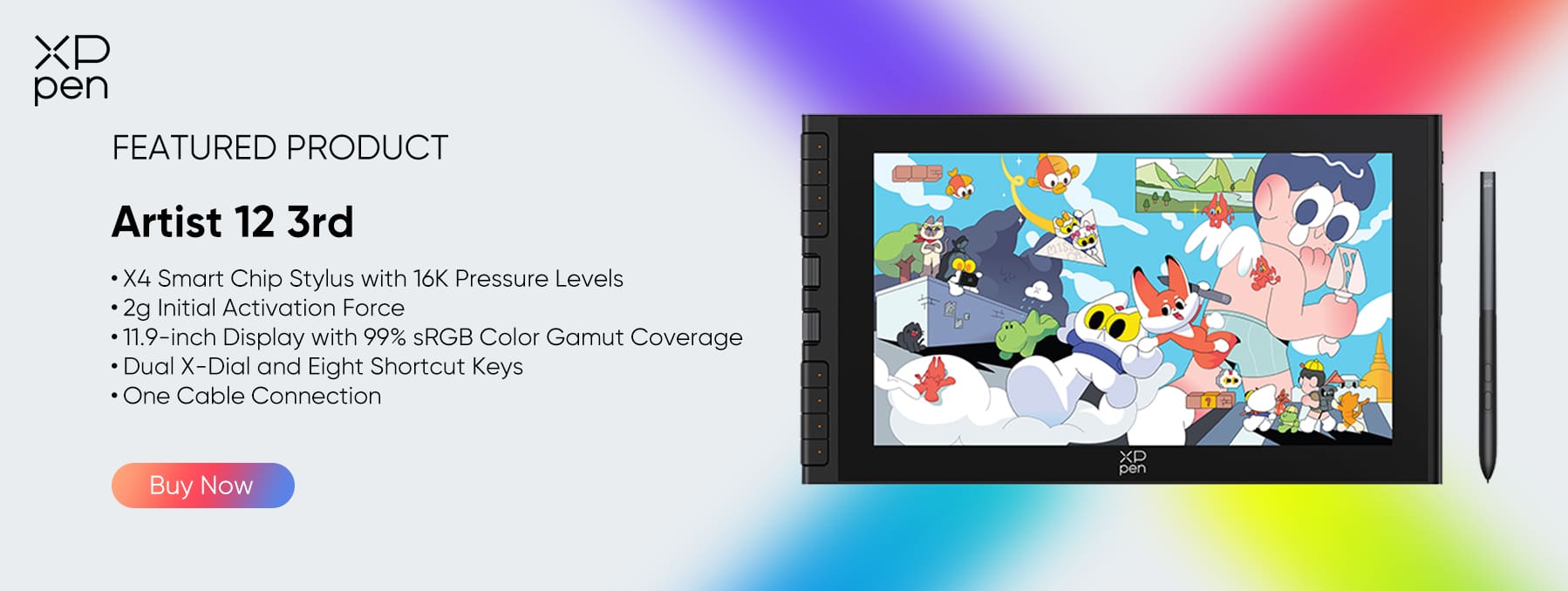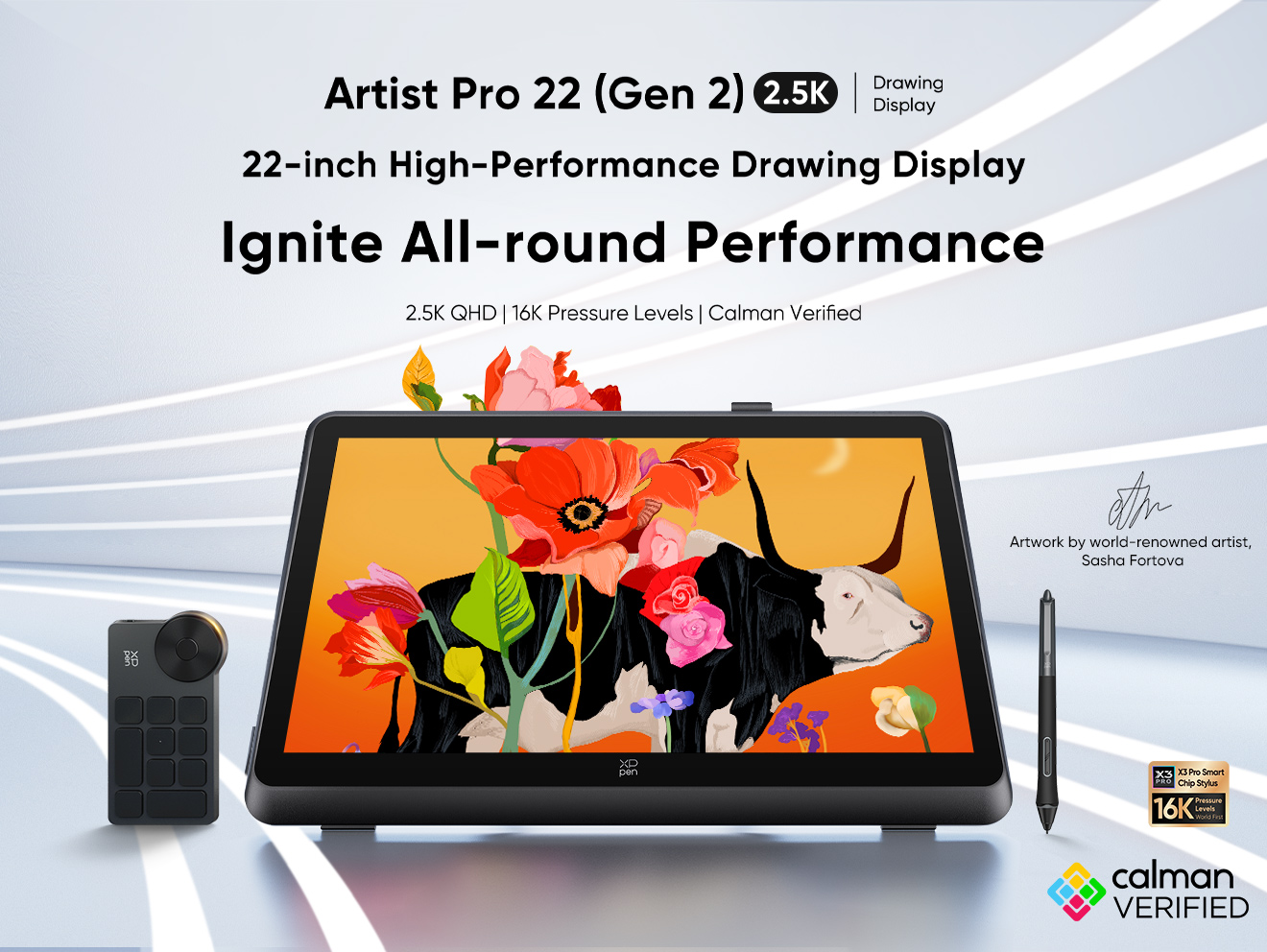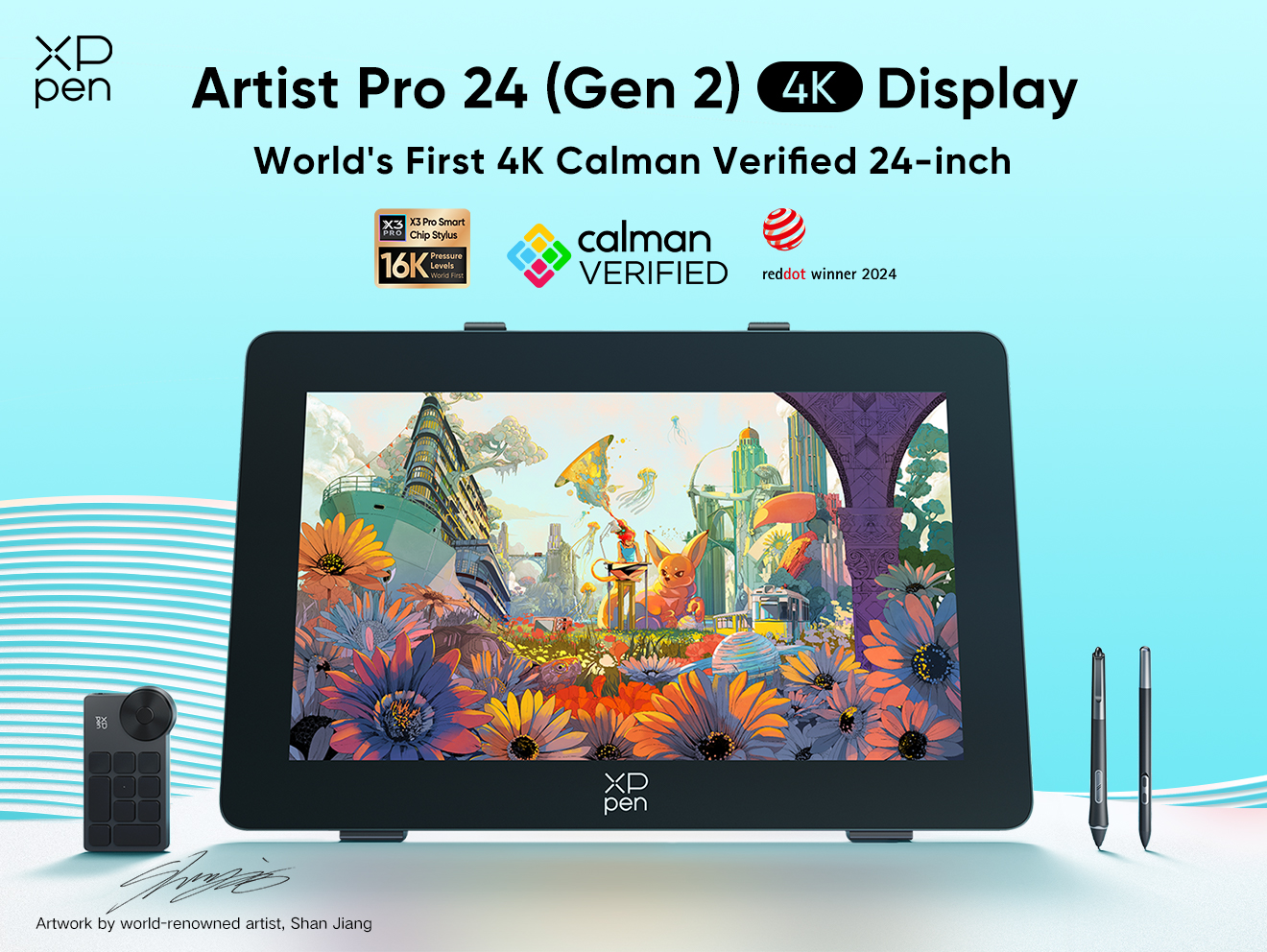
Wacom vs iPad: Which Is Better for Digital Drawing?
ROUNDUPSWhen choosing the best digital drawing tablet, two names often stand out: Wacom and iPad. Wacom is the long-time favorite of professional illustrators, while the iPad—with its Apple Pencil—has revolutionized portable digital art. But which one suits you better? This article breaks down the key differences between Wacom and iPad, compares real product examples, and introduces an exciting alternative — XPPen’s Artist Series, including the beginner-friendly XPPen Artist 12 3rd and the professional-grade XPPen Artist Ultra 16 — both combining affordability with precision and innovation.
Wacom vs iPad
When choosing between Wacom and iPad products, several factors should be considered, including your creative workflow, technical needs, and mobility preferences. Below is a detailed comparison across key dimensions:
Display
Wacom: Offers both pen displays (like the Cintiq series) and pen tablets without screens (like the Intuos line). The displays are known for their high color accuracy, matte finish for a paper-like feel, and large working areas suited for professional illustration or design.
iPad: Features a bright, high-resolution Retina display with excellent color reproduction and smooth touch responsiveness. The glossy screen provides vivid visuals but can be reflective under certain lighting conditions.
Pen Technology
Wacom: The Wacom Pro Pen 2 provides industry-leading pressure sensitivity (up to 8192 levels), tilt recognition, and virtually no lag. It requires no battery, making it reliable for long sessions.
iPad: The Apple Pencil (especially the 2nd generation) offers exceptional precision, low latency, and tilt/pressure sensitivity, though it requires charging. Its integration with iPadOS enhances responsiveness in apps like Procreate and Adobe Fresco.
Portability
Wacom: Typically used with a connected computer or laptop, making it less portable but ideal for stationary studio setups. The Wacom MobileStudio Pro is an exception, offering a self-contained creative workstation.
iPad: Highly portable and self-contained, perfect for sketching or editing on the go. Its lightweight design and long battery life make it convenient for mobile creators.
Operating System & Software
Wacom: Depends on the connected computer’s OS (Windows, macOS, or Linux), allowing access to full desktop versions of creative software such as Adobe Photoshop, Illustrator, and Blender.
iPad: Runs on iPadOS, optimized for touch and Apple Pencil input. It supports powerful apps like Procreate, Affinity Designer, and Adobe Fresco, though these are often lighter versions of desktop counterparts.
Battery Life
Wacom: Traditional pen tablets (like Intuos) draw power from the connected device and don’t need charging. Pen displays consume power through the adapter or USB connection.
iPad: Offers 8–10 hours of continuous use per charge, depending on the model and workload, but requires regular charging of both the device and the Apple Pencil.
In summary:
Choose Wacom if you prioritize professional precision, large workspaces, and advanced pen control for detailed digital art or design.
Choose iPad if you value portability, convenience, and a seamless creative experience that integrates drawing, editing, and productivity in one device.
Next, let’s take a look at some popular Wacom and iPad models to help you choose the right one.
Wacom Products (Representative Models)
Wacom Intuos Pro (Pen Tablet) — A screenless drawing tablet that connects to your computer. It offers advanced pressure sensitivity and customizable shortcut keys, making it ideal for experienced artists who prefer tactile, precision-based control.
Wacom Cintiq 16 (Pen Display) — Features a built-in HD display, enabling you to draw directly on the screen with excellent color accuracy and minimal parallax. A great option for illustrators and animators seeking a natural pen-on-screen experience.
Wacom MobileStudio Pro (Standalone) — A high-end, all-in-one drawing computer that runs full creative software independently. It’s designed for professional artists who need top-tier performance and workstation-level capabilities wherever they go.
iPad Products (Representative Models)
iPad (10th Gen) — The most accessible option, compatible with the 1st-generation Apple Pencil. It’s ideal for beginners, students, or hobbyists experimenting with digital art.
iPad Air (M2) — A lightweight and powerful mid-range model supporting the 2nd-generation Apple Pencil. Perfect for creatives who want professional performance without the Pro-level price tag.
iPad Pro (M4) — Apple’s flagship creative tablet. Equipped with the ultra-fast M4 chip, a Liquid Retina XDR display, and the new Apple Pencil Pro, it delivers near-zero latency, advanced tilt control, and professional-grade precision for serious artists.
While Wacom and Apple’s iPad lineup dominate much of the digital art landscape, they aren’t the only options available to creators. XPPen has emerged as a strong competitor in recent years, offering a balance of performance, affordability, and user-friendly design. With a wide range of models catering to both beginners and professionals, XPPen products provide an accessible entry point into digital illustration and design without compromising on essential creative features. Below are some of XPPen’s top recommended models.
XPPen Products (Alternative Recommendation)
XPPen Artist 12 3rd — A compact, beginner-friendly pen display that features full-lamination technology, vivid colors, dual X-dials, 8 customizable short keys, an X4 Smart Chip stylus, and convenient plug-and-play connectivity. It’s the perfect stepping stone for those starting their digital art journey and seeking an affordable yet professional drawing experience.
XPPen Artist Ultra 16 — Designed for professional creators, this pen display combines a sleek, ultra-slim design with advanced 16K pen pressure sensitivity, X-touch feature, excellent color accuracy, and great portability. It’s ideal for those who want professional-grade performance in a lightweight form.
Key Comparison: XPPen vs Wacom vs iPad
| Feature | Wacom (Cintiq 16 / Intuos Pro) | iPad (Pro / Air) | XPPen (Artist 12 3rd / Artist Ultra 16) |
|---|---|---|---|
| Display | Cintiq: 16” Full HD (matte finish) / Intuos: no screen | Liquid Retina (11"–13") with True Tone | Full laminated display (11.9” / 15.6”) with vibrant color accuracy |
| Pen Technology | EMR (battery-free stylus) | Apple Pencil (battery-powered, magnetic charge) | X4 Smart Chip stylus/X3 Pro Smart Chip stylus (battery-free, 16K pressure) |
| Pressure Sensitivity | Up to 8192 levels | 4096 levels | Up to 16384 levels |
| Connectivity | USB-C / HDMI to computer | Wireless standalone device | Single 3-in-1 USB-C cable / Full-featured USB-C |
| Operating System | Windows, MacOS | iPadOS (standalone) | Windows, MacOS, Android |
| Battery Life | Depends on connected device | 8–10 hours | Depends on connected device |
| Portability | Great | Excellent (light, all-in-one) | Excellent (Ultra 16 is ultra-slim) |
| Supported Software | Photoshop, Illustrator, Clip Studio, etc. | Procreate, Adobe Fresco, Sketchbook | Photoshop, CSP, Krita, Medibang, etc. |
| Best For | Professional studio work | Mobile digital artists | Beginners & professionals |
| Starting Price | Higher | Mid–high | Competitive |
Summary:
Wacom – Best for traditional digital artists who prefer a full desktop setup and advanced pen control.
iPad – Best for mobile creatives who use apps like Procreate for sketching and painting anywhere.
XPPen – Best all-round option, balancing performance, portability, and affordability for both beginners and professionals.
FAQ
Q1: Is Wacom or iPad better for beginners?
For beginners, the iPad is generally easier to use. It’s ideal for those already familiar with the Mac ecosystem or who prefer a standalone drawing device. The iPad combines the screen and pen in one, making it intuitive and similar to traditional drawing.
Wacom tablets, on the other hand, are “hand-eye separated” devices—you draw on the tablet while watching the results on your computer screen. This takes some time to get used to, but Wacom offers excellent precision and compatibility with professional software, making it a favorite among advanced users.
If you’d like a more affordable way to experience screen drawing, the XPPen Artist 12 3rd is a great entry-level option. It offers pen display precision at a lower price, serving as a smooth step toward professional digital art.
Q2: Can I use Wacom or XPPen without a computer?
Most Wacom and XPPen pen displays need a computer, but XPPen Magic Drawing Pad and Wacom MobileStudio Pro are standalone models.
Q3: Which offers better pen accuracy?Wacom and XPPen use battery-free EMR pens with high pressure levels, offering smoother control than the Apple Pencil. For instance, XPPen's latest X4 Smart Chip stylus features 16K pressure sensitivity, ensuring more vivid and precise strokes.
Q4: Can I use Procreate on Wacom or XPPen?
No, Procreate is iPad-only, but Wacom and XPPen support powerful alternatives like Clip Studio Paint and Krita.
Q5: Which tablet is most portable?
The iPad Pro and XPPen Artist Ultra 16 are both slim and travel-friendly, making them ideal for mobile creativity.
Conclusion
Choosing between Wacom and iPad ultimately depends on your creative workflow and priorities — but today, there’s a third contender worth serious consideration: XPPen.
Wacom remains the top choice for professionals seeking studio-level precision and a traditional creative setup.
The iPad offers freedom, flexibility, and mobility, perfect for artists who love drawing anywhere.
XPPen, with the Artist 12 3rd for beginners and Artist Ultra 16 for professionals, bridges the gap — offering powerful performance, portability, and value in one package.
In short, if you’re looking for the perfect balance between Wacom’s precision and iPad’s portability — without the premium price tag — XPPen delivers the best of both worlds.
About Us
Founded in 2005, XPPen is a leading global brand in digital art innovation under Hanvon UGEE. XPPen focuses on the needs of consumers by integrating digital art products, content, and services, specifically targeting Gen-Z digital artists. XPPen currently operates in 163 countries and regions worldwide, boasting a fan base of over 1.5 million and serving more than ten million digital art creators.
Learn moreReady to invest in the right tools?
Get expert buying advice, unbiased reviews, and exclusive deals on drawing tablets, and accessories.











